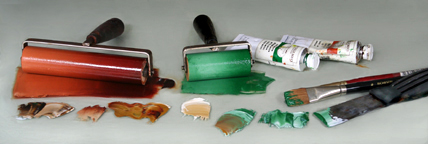|
Resources and Links

PRINTMAKING
TERMS:
Fine-art printmaking:
Fine-art printmaking involves transferring an image from
a plate to another surface such as paper. Hand-pulled
original prints can be one-of-a-kind, or
limited-editions (multiples) depending on the methods
used.
Fine-art and limited-edition prints should not be
confused with giclées which are reproductions and not
original artwork. See Prints versus Reproductions by
Carolyn Blakeslee.
http://www.artcalendar.com/article.asp?ID=80
Chine Collé:
Torn paper (sometimes Japanese papers) is placed on an
inked plate and then printed. That paper becomes
attached to the final print, with the inked image
appearing on both.
Collagraph:
A collagraph plate is made by putting textured materials
(gels, modeling pastes, found objects, fabrics, organic
materials, and cardboard shapes) onto a hard flat
surface. You ink and wipe the recessed areas (intaglio),
roll ink upon the raised areas (relief), or print
inkless (emboss). The image is usually transferred on an
etching press.
Intaglio:
Intaglio processes include etching, engraving, drypoint,
mezzotint, aquatint, soft ground, and lift ground, or a
combination. The imagery is incised into a plate with
various tools or by etching. Traditional plates are
zinc, copper, and plexiglass. More contemporary ones are
solarplate and Itaglio-Type. The incised areas are
inked, the surface wiped, and the plate is printed on an
etching press. Editions can be made.
An embossed print has raised areas throughout the print
from the incised areas of the plate.
À la poupée means the printer uses several different
colors of ink on the intaglio plate.
Mixed Media:
Contemporary printmakers sometimes do hand-coloring,
apply paints, pastels, crayon, and pencils marks, or add
collage, digital imagery, and found objects to there
monotypes and monoprints.
Monotype:
A monotype uses a combination of printmaking, painting,
and drawing techniques which are created on top of a
plate and are transferred to paper (or other surfaces)
by hand or on a printing press. Plates can be metal,
glass, Plexiglass, mylar, and wood. Brushes, brayers,
rollers and other tools are used to apply printmaking
inks, various paints, and solvents. Pencils and crayons
also create the imagery. This process results in a
one-of-a-kind print. 1/1
Monoprint:
A monoprint is similar to a monotype, but it also
includes other reproducible printmaking processes such
as intaglio, lithography, woodcut, linocuts, and
silkscreen. This process results in a one-of-a-kind
print. 1/1
Lithograph:
In lithography, the chemical reaction of water versus
grease creates the printed image. The surface of a stone
or metal plate is built up with greasy substances (tusche,
crayon, pencils) which are etched and fixed. The surface
remains smooth, unlike an intaglio plate which is
incised. Ink is rolled onto the plate, using water and
gum arabic washing and wiping techniques. It is printed
on a lithography press. Editions can be made.
Relief:
In relief printing, the surface of the plate produces
the image. If plate areas are cut away, they do not
print. The plate is rolled with brayers or rollers and
can be printed by hand (rubbing with a special tools) or
on a press. Woodcuts, linocuts, stencil, stamping,
plaster blocks, and collage relief are examples of
relief printing. Relief rolls on mylar shapes or
illustration board cutouts are common ways way to create
background colors for intaglio prints.
Silkscreen / Screen print /Serigraph:
Very fine fabric (silk) is stretched over a frame, and
stenciled areas are blocked out. Ink is passed through
the open areas to transfer the image to the final
surface (paper, cloth…).
Solarplate:
A solarplate is a thin light/photo sensitive steel
backed polymer plate that is exposed with U.V. light and
developed with water. It is an intaglio plate.
Xerox Printing / Gum Arabic Transfer:
Black and white Xerox images are used as a paper litho
plate. The Xerox plates are inked, washed, and wiped
with gum arabic in a similar manner to lithograph
printing.
LINKS:
News article about making
Arborglyphs monoprints.
http://www.timescall.com/entertainment/ci_25761444/colorado-woman-makes-art-using-aspen-tree-bark
Linda C Everson talks about
printmaking.
http://www.blogtalkradio.com/annette-coleman/2011/04/08/printmaking-with-guest-host-linda-everson-master-printer
ArtistsRegister.com - Linda
C. Everson
http://www.artistsregister.com/artists/CO1556
ArtBizCoach.com - Marketing and Business Coaching for
Artists
http://www.artbizcoach.com/
ArtworkNetwork.com - Online gallery of artists, plus art
consulting services.
http://www.artworknetwork.com
Blog Talk Radio - Annette Coleman -
Thursday night web based audio discussion between hosts
and artists about visual art.
http://www.blogtalkradio.com/annette-coleman
DanielSmith.com - finest quality artist materials
http://www.danielsmith.com/
Graphic Chemical Ink Company - Inks, tools, papers,
supplies
http://www.graphicchemical.com/
NonToxicPrint.com -
A
Research Resource
and
Practical Guide
for
Printmakers, Artists
and
Educators
http://www.nontoxicprint.com/
Professional Artist Magazine
- A business magazine and online source for visual
artists.
http://professionalartistmag.com
SolarPlate.com - Solar Etching, an innovative,
safer approach to printmaking
http://www.solarplate.com/
WhiteWingDesign.com - Web sites designed
for artists
http://www.whitewingdesign.com
8888-Art-Look - An
audio service where viewers can hear descriptions of the
artwork on their cell phones.
http://www.8888artlook.com
|